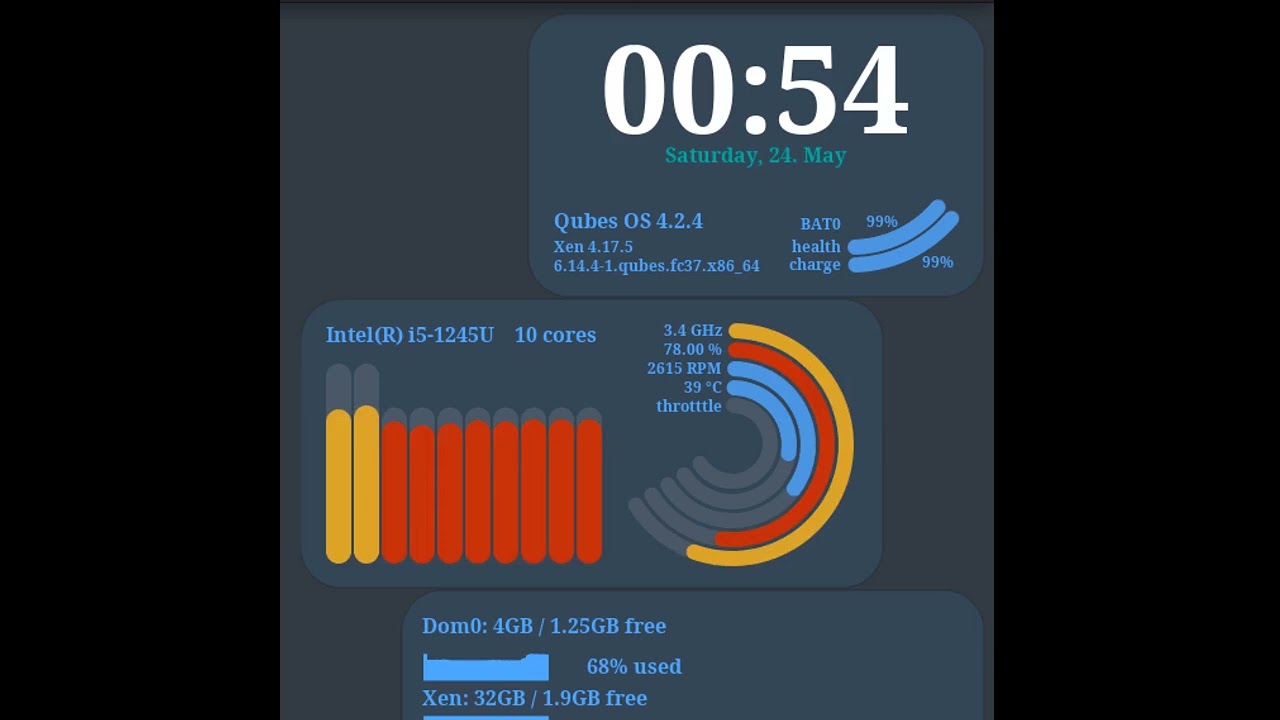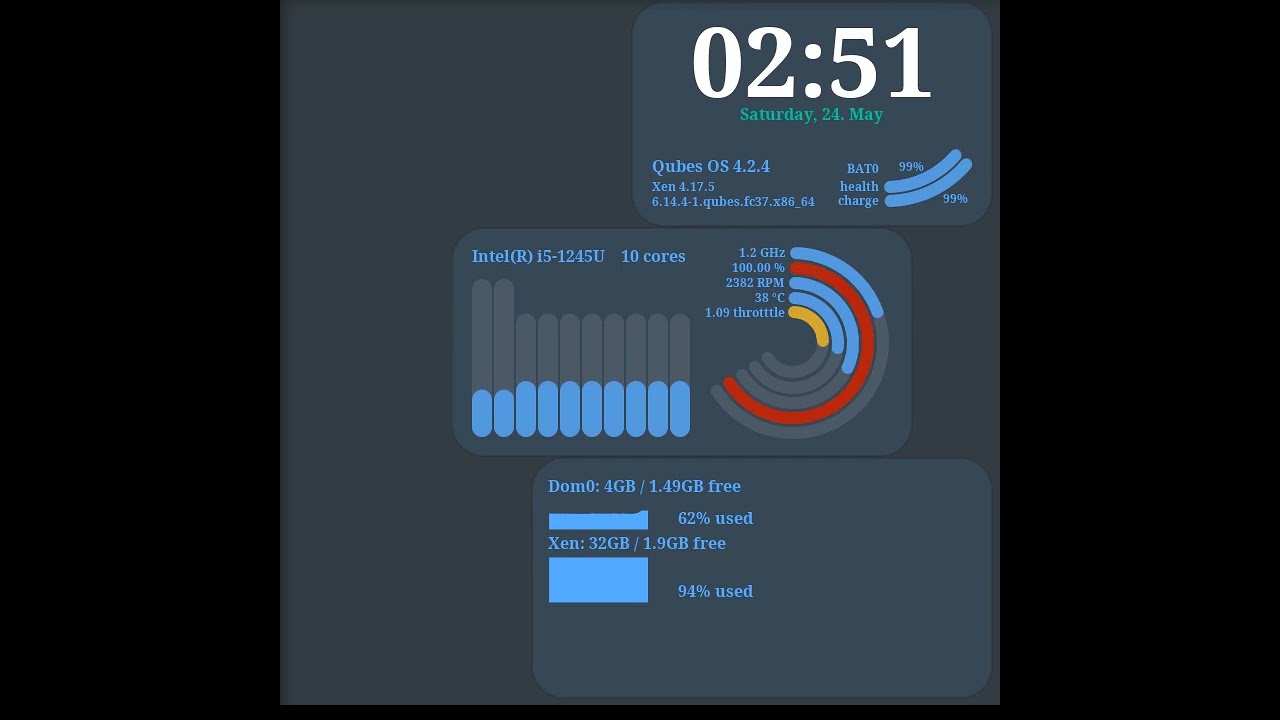I have been trying to improve the battery life on my thinkpad. I have been getting on average about 2 hours. The battery is 57Wh. I have installed TLP on all templates including dom0. In the tlp.conf file I have (in all templates):
# ------------------------------------------------------------------------------
# /etc/tlp.conf - TLP user configuration (version 1.4)
# See full explanation: https://linrunner.de/tlp/settings
#
# Settings are read in the following order:
#
# 1. Intrinsic defaults
# 2. /etc/tlp.d/*.conf - Drop-in customization snippets
# 3. /etc/tlp.conf - User configuration (this file)
#
# Notes:
# - In case of identical parameters, the last occurence has precedence
# - This also means, parameters enabled here will override anything else
# - However you may append values to a parameter already defined as intrinsic
# default or in a previously read file: use PARAMETER+="add values"
# - IMPORTANT: all parameters here are disabled; remove the leading '#' if you
# like to enable a feature without default or have a value different from the
# default
# - Default *: intrinsic default that is effective when the parameter is missing
# or disabled by a leading '#'; use PARAM="" to disable an intrinsic default
# - Default <none>: do nothing or use kernel/hardware defaults
# -
# ------------------------------------------------------------------------------
# tlp - Parameters for power saving
# Set to 0 to disable, 1 to enable TLP.
# Default: 1
TLP_ENABLE=1
# Control how warnings about invalid settings are issued:
# 0=disabled,
# 1=background tasks (boot, resume, change of power source) report to syslog,
# 2=shell commands report to the terminal (stderr),
# 3=combination of 1 and 2
# Default: 3
TLP_WARN_LEVEL=3
# Operation mode when no power supply can be detected: AC, BAT.
# Concerns some desktop and embedded hardware only.
# Default: <none>
#TLP_DEFAULT_MODE=AC
# Operation mode select: 0=depend on power source, 1=always use TLP_DEFAULT_MODE
# Note: use in conjunction with TLP_DEFAULT_MODE=BAT for BAT settings on AC.
# Default: 0
TLP_PERSISTENT_DEFAULT=0
# Power supply classes to ignore when determining operation mode: AC, USB, BAT.
# Separate multiple classes with spaces.
# Note: try on laptops where operation mode AC/BAT is incorrectly detected.
# Default: <none>
#TLP_PS_IGNORE="BAT"
# Seconds laptop mode has to wait after the disk goes idle before doing a sync.
# Non-zero value enables, zero disables laptop mode.
# Default: 0 (AC), 2 (BAT)
#DISK_IDLE_SECS_ON_AC=0
#DISK_IDLE_SECS_ON_BAT=2
# Dirty page values (timeouts in secs).
# Default: 15 (AC), 60 (BAT)
#MAX_LOST_WORK_SECS_ON_AC=15
#MAX_LOST_WORK_SECS_ON_BAT=60
# Select a CPU frequency scaling governor.
# Intel processor with intel_pstate driver:
# performance, powersave(*).
# Intel processor with intel_cpufreq driver (aka intel_pstate passive mode):
# conservative, ondemand, userspace, powersave, performance, schedutil(*).
# Intel and other processor brands with acpi-cpufreq driver:
# conservative, ondemand(*), userspace, powersave, performance, schedutil(*).
# Use tlp-stat -p to show the active driver and available governors.
# Important:
# Governors marked (*) above are power efficient for *almost all* workloads
# and therefore kernel and most distributions have chosen them as defaults.
# You should have done your research about advantages/disadvantages *before*
# changing the governor.
# Default: <none>
CPU_SCALING_GOVERNOR_ON_AC=performance
CPU_SCALING_GOVERNOR_ON_BAT=powersave
# Set the min/max frequency available for the scaling governor.
# Possible values depend on your CPU. For available frequencies see
# the output of tlp-stat -p.
# Notes:
# - Min/max frequencies must always be specified for both AC *and* BAT
# - Not recommended for use with the intel_pstate scaling driver, use
# CPU_MIN/MAX_PERF_ON_AC/BAT below instead
# Default: <none>
#CPU_SCALING_MIN_FREQ_ON_AC=0
#CPU_SCALING_MAX_FREQ_ON_AC=0
#CPU_SCALING_MIN_FREQ_ON_BAT=0
#CPU_SCALING_MAX_FREQ_ON_BAT=0
# Set Intel CPU energy/performance policies HWP.EPP and EPB:
# performance, balance_performance, default, balance_power, power.
# Values are given in order of increasing power saving.
# Notes:
# - HWP.EPP: requires kernel 4.10, intel_pstate scaling driver and Intel Core i
# 6th gen. or newer CPU
# - EPB: requires kernel 5.2 or module msr and x86_energy_perf_policy from
# linux-tools, intel_pstate or intel_cpufreq scaling driver and Intel Core i
# 2nd gen. or newer CPU
# - When HWP.EPP is available, EPB is not set
# Default: balance_performance (AC), balance_power (BAT)
CPU_ENERGY_PERF_POLICY_ON_AC=performance
CPU_ENERGY_PERF_POLICY_ON_BAT=power
# Set Intel CPU P-state performance: 0..100 (%).
# Limit the max/min P-state to control the power dissipation of the CPU.
# Values are stated as a percentage of the available performance.
# Requires intel_pstate or intel_cpufreq driver and Intel Core i 2nd gen. or
# newer CPU.
# Default: <none>
CPU_MIN_PERF_ON_AC=0
CPU_MAX_PERF_ON_AC=100
CPU_MIN_PERF_ON_BAT=0
CPU_MAX_PERF_ON_BAT=30
# Set the CPU "turbo boost" (Intel) or "turbo core" (AMD) feature:
# 0=disable, 1=allow.
# Note: a value of 1 does *not* activate boosting, it just allows it.
# Default: <none>
CPU_BOOST_ON_AC=1
CPU_BOOST_ON_BAT=0
# Set the Intel CPU HWP dynamic boost feature:
# 0=disable, 1=enable.
# Requires intel_pstate scaling driver in 'active' mode and Intel Core i
# 6th gen. or newer CPU.
# Default: <none>
CPU_HWP_DYN_BOOST_ON_AC=1
CPU_HWP_DYN_BOOST_ON_BAT=0
# Minimize number of used CPU cores/hyper-threads under light load conditions:
# 0=disable, 1=enable.
# Default: 0 (AC), 1 (BAT)
SCHED_POWERSAVE_ON_AC=0
SCHED_POWERSAVE_ON_BAT=1
# Kernel NMI Watchdog:
# 0=disable (default, saves power), 1=enable (for kernel debugging only).
# Default: 0
NMI_WATCHDOG=0
# Select platform profile:
# performance, balanced, low-power.
# Controls system operating characteristics around power/performance levels,
# thermal and fan speed. Values are given in order of increasing power saving.
# Note: check the output of tlp-stat -p to determine availability on your
# hardware and additional profiles such as: balanced-performance, quiet, cool.
# Default: <none>
PLATFORM_PROFILE_ON_AC=performance
PLATFORM_PROFILE_ON_BAT=low-power
# Define disk devices on which the following DISK/AHCI_RUNTIME parameters act.
# Separate multiple devices with spaces.
# Devices can be specified by disk ID also (lookup with: tlp diskid).
# Default: "nvme0n1 sda"
#DISK_DEVICES="nvme0n1 sda"
# Disk advanced power management level: 1..254, 255 (max saving, min, off).
# Levels 1..127 may spin down the disk; 255 allowable on most drives.
# Separate values for multiple disks with spaces. Use the special value 'keep'
# to keep the hardware default for the particular disk.
# Default: 254 (AC), 128 (BAT)
#DISK_APM_LEVEL_ON_AC="254 254"
#DISK_APM_LEVEL_ON_BAT="128 128"
# Exclude disk classes from advanced power management (APM):
# sata, ata, usb, ieee1394.
# Separate multiple classes with spaces.
# CAUTION: USB and IEEE1394 disks may fail to mount or data may get corrupted
# with APM enabled. Be careful and make sure you have backups of all affected
# media before removing 'usb' or 'ieee1394' from the denylist!
# Default: "usb ieee1394"
#DISK_APM_CLASS_DENYLIST="usb ieee1394"
And the rest is all standard.
The settings I changed in this was:
TLP_ENABLE=1
TLP_WARN_LEVEL=3
TLP_PERSISTENT_DEFAULT=0
CPU_SCALING_GOVERNOR_ON_AC=performance
CPU_SCALING_GOVERNOR_ON_BAT=powersave
CPU_ENERGY_PERF_POLICY_ON_AC=performance
CPU_ENERGY_PERF_POLICY_ON_BAT=power
CPU_MIN_PERF_ON_AC=0
CPU_MAX_PERF_ON_AC=100
CPU_MIN_PERF_ON_BAT=0
CPU_MAX_PERF_ON_BAT=30
CPU_BOOST_ON_AC=1
CPU_BOOST_ON_BAT=0
CPU_HWP_DYN_BOOST_ON_AC=1
CPU_HWP_DYN_BOOST_ON_BAT=0
SCHED_POWERSAVE_ON_AC=0
SCHED_POWERSAVE_ON_BAT=1
NMI_WATCHDOG=0
PLATFORM_PROFILE_ON_AC=performance
PLATFORM_PROFILE_ON_BAT=low-power
However, it is still outputting 12w while doing basic stuff like having one appvm open browsing on a few tabs. When I do sudo tlp-stat -p it says
BAT0-acpi-0
Adapter: ACPI interface
in0: 10.83 V
power1: 12.15 W
For a i5 1235U, I would have expected less.
Now, I was looking into the intel pstate, but when I typed into terminal
sudo dmesg | grep intel_pstate
I got back
[ 3.895872] intel_pstate: CPU model not supported
This is a fairly new cpu and I would have expected it to be supported by intel pstate.
The reason I ask this is because to help battery life I wanted to limit the CPU frequency in tlp, but the settings for this states that it shouldn’t be done if the CPU can use intel pstate here:
# Set the min/max frequency available for the scaling governor.
# Possible values depend on your CPU. For available frequencies see
# the output of tlp-stat -p.
# Notes:
# - Min/max frequencies must always be specified for both AC *and* BAT
# - **Not recommended for use with the intel_pstate scaling driver**, use
# CPU_MIN/MAX_PERF_ON_AC/BAT below instead
# Default: <none>
#CPU_SCALING_MIN_FREQ_ON_AC=0
#CPU_SCALING_MAX_FREQ_ON_AC=0
#CPU_SCALING_MIN_FREQ_ON_BAT=0
#CPU_SCALING_MAX_FREQ_ON_BAT=0
Another strange thing is that when I sudo tlp-stat -p it doesn’t tell me what frequencies are available. Instead I get this
--- TLP 1.5.0 --------------------------------------------
+++ Processor
CPU model = 12th Gen Intel(R) Core(TM) i5-1235U
/sys/devices/system/cpu/cpufreq/boost = (not available)
/sys/module/workqueue/parameters/power_efficient = N
/proc/sys/kernel/nmi_watchdog = 0
+++ Platform Profile
/sys/firmware/acpi/platform_profile = (not available)
/sys/firmware/acpi/platform_profile_choices = (not available)
Do you have any ideas on this? It is quite confusing and I really want to improve the battery life to be better than 2 hours!

